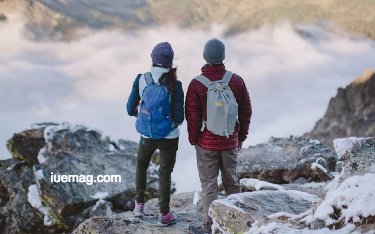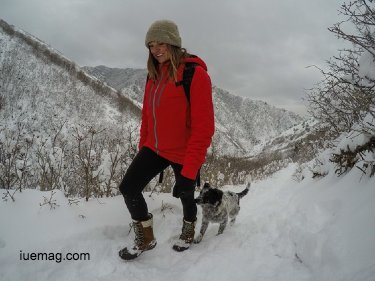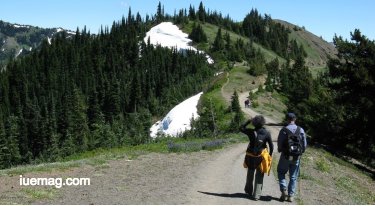

A Basic Guide for the Perfect Hiking Clothes

Hiking is a wonderful activity that helps you connect with nature on a deeper level. However, it can also be dangerous if you’re not careful or well-informed.
Even something as simple as what you’re wearing can greatly affect your experience. Sure, you want to look good and post pictures on Instagram. But if you’re really serious about hiking, comfort and functionality always come first.
Luckily, because hiking is becoming more popular, there are a variety of clothing options that you can choose from. But so many choices can be a little overwhelming, especially if you’re a new hiker.
Don’t worry though, because we’ve got you covered. Keep reading for some basic guidelines on how to dress when you go hiking.
Avoid Cotton
When we think about hiking, we obviously want comfort. And when looking for comfort, we tend to reach for cotton first. I mean, why not? It’s airy, breathable, and never itchy!
But here’s some news for you - cotton is a very bad fabric choice for activities like hiking and mountaineering!
Cotton traps sweat and water within your clothes. This will make you feel warmer in the heat, and chilly in the cold weather.
Also, since cotton absorbs water quickly, it gets pretty heavy and difficult to dry. And these are definitely not the qualities you want in your hiking apparel.
Instead, you should pick fabrics that will regulate your temperature. So, light, easy to dry wicking materials like wool, nylon, and polyester is good options.
Layer Up
If you’re doing a more intense hike in rough weather conditions, layering up is mandatory. This is so that you are well insulated and protected from the weather.
The layers you wear should be easy to take off. This helps you adjust to temperature changes. Typically, hikers follow a three-layer system with a base, mid, and shell layer.
Base Layer
These are the very first clothes you put on. Basically, it consists of underwear, tank tops, shirts, etc. They’re in direct contact with your skin and have nothing beneath them.
The function of the base layer is to keep sweat away from your other clothes. It helps you to stay dry during your hike. Common materials used for this layer are Merino wool and Polyester.

Mid Layer
The mid layer is the clothes you wear over the base layer. It is meant to keep you warm and insulated as protection against the cold. So, any sweaters or jackets would fit the bill.
You can wear more than one item of clothing for the mid layer, but make sure that it doesn’t become too heavy on your body. Your clothes should be light, so that you can move freely.
Shell Layer
The shell layer is the outer layer that keeps you protected from wind and rain. It can be worn directly over the mid or the base layer, depending on how warm or cold it is.
Adding a third layer can make it heavier for hikers. That’s why this is optional and only meant for rainy or windy weather.
The clothes need to be water and wind resistant. This can have a negative effect on breathability. Nowadays, there are many brands that cater to all these requirements.
Pay Attention to the Clothing Details
When hiking, you need your clothes to be easily adjusted. So, the small details really do matter.
For instance, simply being able to roll up your sleeves is a big plus.
When you get jackets, check if they have functional zippers.
Try to buy clothes that have added features like hoodies to protect your head. And of course, big pockets are always beneficial.
Your clothes should also be easy to fold and pack away when you take them off. You don’t want them taking up space in your bag.
Fitted or Loose?
Whether they’re fitted or loose, hiking clothes should always be easy to move in.
For colder weather, stick to tight-fitting clothes. These tend to be more insulated and retain body heat. In warmer temperatures, loose-fitting clothes are better. These are easily ventilated, keeping your body cool.
Now, loose clothes don’t mean ill-fitting. You don’t want your top to be so loose that it riles up while you hike. In hot weather, make sure that your clothes actually fit, but are airy at the same time.

Bottoms
You can wear any type of bottoms for your hiking trip, but it’s always advised to wear pants or shorts, depending on the weather.
Just make sure that the bottoms are durable and won’t tear easily. Your bottoms need to protect you from the weather, as well as the trail, which could be rocky, sharp or wet.
If it’s not too hot, opt for fully-covered pants. These will save you from cuts and scratches. They will also prevent any direct contact of poisonous plants with your skin.
And if you’re thinking of wearing yoga pants for an intense hike, ditch that idea immediately. They may be comfortable and look great in pictures, but they’re not very protective.
Also, tight-fitting yoga pants make it easy for you to get insect bites. However, you could consider wearing the “athleisure” clothes that brands have been coming up with recently. They’re more catered to hiking needs.
Undergarments
What you wear below your clothes is a big deal when hiking. Don’t just wear any old pair of undergarments. Whether you’re wearing a bra or boxers - if you’ve got seams sticking out, they’re bound to get itchy.
Hiking underwear for men and women alike should always be comfortable and durable. You shouldn’t have to worry about chafing or bunching while you’re walking across rocky terrain.
The undergarments should also have antimicrobial properties. It can get pretty moist in your private parts, especially during hiking. So keeping bacteria away is of the utmost importance.
Merino wool has natural antibacterial properties, but you could also opt for undergarments made of synthetic materials. These are created especially for this purpose.
What About Shoes?
What shoes you wear will really define your hiking experience. Your feet have a lot of work to do, so it’s important that you dress them well.
Your shoes should be well-covered and fitted. They should be durable and most importantly, comfortable. So it can be just a basic pair of sneakers that fit all these criteria if you’re only going for a simple short hike.
For longer hikes, people are always advised to wear hiking boots. These are perfect for simple trips and provide the basic protection from insects and thorns that you’ll need.
Your shoes should also be waterproof and breathable. You never know when you might have to cross a stream or two!
For more serious trips that involve rock climbing, get specialized hiking shoes. Hiking shoes are designed to handle all sorts of terrains. They’re much more flexible and secure.
Accessories
Hiking accessories are important as well. Here are the essentials that you shouldn’t forget:
Headwear
Headwear comes in handy in every weather. For the cold, an insulated cap will keep your head warm. These make a huge difference in how much body heat you lose.
And of course, on sunny days, a cap will protect your eyes, face, and neck from the sun. Caps can also prevent your head from becoming overheated when temperatures are high.
Even wearing a simple bandana or baseball cap will give your head the protection that it needs.
Bags
The size of the bag you carry depends on your hiking duration and miles. Your bag should be lightweight and functional. It should also be waterproof so that the contents don’t get ruined.
Sometimes having an extra fanny pack around your waist is super helpful as well. This way, you don’t have to reach for your backpack every time you want your phone.

Gloves
For cold weather, gloves are essential. Fingers are very susceptible to frostbite, so you’ll have to take extra care when protecting them.
You can either layer your gloves or wear ones that serve all purposes. All-in-one gloves are well-insulated, but not ideal for all weather conditions.
They’re not very flexible when it comes to adjusting to temperature. Layered gloves work like the cloth layering system mentioned above. These allow you to adjust your protection according to your needs.
Socks
In cold weather, you’ll also need a sturdy pair of socks. Socks take away perspiration from the feet and stop them from getting too cold. They also prevent friction and blisters.
What’s more, they’re an added layer of protection from insects and thorns. So even if it is summer, you should consider wearing a lighter pair of socks.
Final Thoughts
Now that you’ve read the whole guide, I’m sure that you’re well-versed with hiking apparel. It’s not that complicated if you follow these simple rules.
Just make sure that you do your research and use your common sense as well. Hiking itself is a strenuous activity, so you don’t want the additional stress of having uncomfortable clothing.
If it’s a simple, short hike, your normal clothes will do, as long as you follow a few basic rules. But on more serious hikes over longer miles, you should definitely invest in some good hiking apparel.
So, make wise clothing choices and go on the hiking adventure you’ve been dreaming of!
Author Bio: Angie Grey, an expert author from Faveable.com brings you all you need to know about fashion and grooming. She loves the outdoors and travels the world like a nomad.
Copyrights © 2025 Inspiration Unlimited - iU - Online Global Positivity Media
Any facts, figures or references stated here are made by the author & don't reflect the endorsement of iU at all times unless otherwise drafted by official staff at iU. A part [small/large] could be AI generated content at times and it's inevitable today. If you have a feedback particularly with regards to that, feel free to let us know. This article was first published here on 2nd May 2019.
Overthinking? Uninspired? Brain Fogged?
Let's Reset That! Try iU's Positivity Chat NOW!

All chats are end-to-end encrypted by WhatsApp and won't be shared anywhere [won't be stored either].


